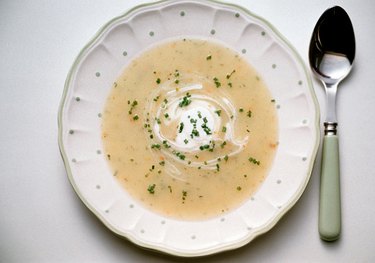
Roux is a cooked mixture of flour and fat used to thicken sauces, gravies and soups. It's made by heating equal parts flour and butter until your concoction is the consistency of cake frosting. Depending on how long it's cooked, you can make white, blond, brown or dark brown roux (pronounced "roo"). If you make it in a big batch, it'll keep frozen for months -- try dividing it into ice cube trays -- or in the fridge for more than a week. Making a bigger batch will lessen the likelihood of burning it, and some cooks like keeping roux around the kitchen.
Simple Science
Video of the Day
Heating flour expands the starch in it. When combined with the butter, which makes the flour malleable, your mixture can be stiffened into a paste and can be added to a sauce or soup to thicken it. The word "roux" is from a French word for "reddish brown," or "red-haired." Depending on which cook you ask, there are either three or four types of roux. Since dark brown roux is a poor thickening agent, some cooks don't count it as a roux.
Video of the Day
Basics
In a heavy-bottomed pan over medium heat, melt your butter, then add a pinch of all-purpose flour. If the butter bubbles, pour in the rest of your flour, stirring with a wooden spoon. In three to five minutes, you'll find the mixture has the consistency of cake frosting. The longer you cook it -- continually stirring -- the darker it gets. Don't let it burn.
Colors

White roux needs less than five minutes to cook. This is most often used in white sauces. White soups like potato and milk-based soups also use a white roux. Blond roux is cooked a bit longer and comes out a pale golden color. It's used to thicken and enrich stock-based soups. It adds a bit of nutty flavor.
Brown Roux is cooked longer still. This is the color of a perfect pancake and creates a rich nutty aroma. But when the flour is cooked long enough to reach this color and taste, it loses some of its thickening power, so more is needed. This roux is generally used in chowders and gumbos. Dark Brown Roux is cooked the longest and is used more for its flavor than thickening.
Considerations
If you're using roux primarily as a thickening agent, the two lighter shades do the best job. If you're looking to add flavor, use darker roux for its nutty taste. In addition, you can use oil in place of butter, depending on the flavor you want to add.